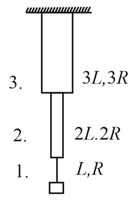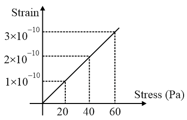EASY
Earn 100
Lengths L, 2L and 3L and radii R, 2R and 3R of three wires of same material (Young's modulus Y) respectively which are joined end to end with weight is suspended as shown below. Find the elastic neglecting the self weight

(a)
(b)
(c)
(d)
50% studentsanswered this correctly
Important Questions on Elasticity
MEDIUM
The elastic behaviour of material for linear stress and linear strain, is shown in the figure. The energy density for a linear strain of is _____ . Assume that material is elastic upto the linear strain of .

EASY
MEDIUM
MEDIUM
EASY
MEDIUM
(Young's modulus of steel )
HARD
MEDIUM
EASY
[Young's modulus of wire ]
EASY
(take )
EASY
HARD
(gravitational acceleration)
EASY
MEDIUM
MEDIUM
= Young's modulus of the material of rod, coefficient of linear expansion
MEDIUM
HARD
MEDIUM
MEDIUM

